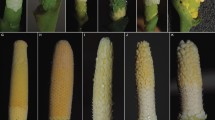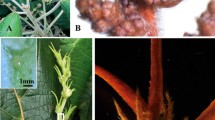Summary.
In the family Araceae, the members of all subfamilies except Aroideae follow the conventional mode of exine formation pattern, which conforms with the textbook view of sporoderm stratification and chemistry (sporopollenin ektexine formed before the endexine). Only members of the subfamily Aroideae show a quite uncommon mode of exine formation pattern, with an endexine formed prior to the nonsporopollenin, polysaccharidic outer exine layer. The intine is formed simultaneously with this non-sporopollenin layer. From the differing timetable and especially from the different origin it is concluded that this outer exine layer is not homologous to the angiosperm ektexine. The fundamental question, why members of the Aroideae lack an elaborated sporopollenin ektexine, is discussed in terms of functionality of the nonsporopollenin outer exine layer. It seems that a major change in aroid evolution took place at the point when the family phylogenetically and ecologically shifted from bisexual (most subfamilies) to unisexual flowers (Aroideae only). The hypothesis is that ephemeral spathes and the absence of sporopollenin are the consequence of an adaptive syndrome for a short pollination time window in many members of the Aroideae, with short-lived pollen, an energetically not costly pollen wall, rapid germination of pollen tube, and brief receptivity of stigma.
Similar content being viewed by others
References
J Bogner M Hesse (2005) ArticleTitleZamioculcadoideae, a new subfamily of Araceae Aroideana 28 3–20
EM Friis KJ Pedersen PR Crane (2004) ArticleTitleAraceae from the Early Cretaceous of Portugal: evidence on the emergence of monocotyledons Proc Natl Acad Sci USA 101 16565–16570 Occurrence Handle15546982 Occurrence Handle1:CAS:528:DC%2BD2cXhtVOisbjK Occurrence Handle10.1073/pnas.0407174101
C Furness P Rudall (1999) ArticleTitleInaperturate pollen in monocotyledons Int J Plant Sci 160 395–414 Occurrence Handle10.1086/314129
Govaert R, Frodin DG (2002) World checklist and bibliography of Araceae (and Acoraceae). Royal Botanic Gardens, Kew
H Halbritter (1998) ArticleTitlePreparing living pollen material for scanning electron microscopy using 2,2-dimethoxypropane (DMP) and criticalpoint drying Biotech Histochem 73 137–143 Occurrence Handle9674883 Occurrence Handle1:STN:280:DyaK1czjslKnsg%3D%3D Occurrence Handle10.3109/10520299809140519
A Hay DJ Mabberley (1991) ArticleTitle“Transference of Function” and the origin of aroids: their significance in early angiosperm evolution Bot Jahrb 113 339–428
M Hesse M Weber H Halbritter (1999) ArticleTitlePollen walls of Araceae, with special reference to their fossilization potential Grana 38 203–209 Occurrence Handle10.1080/001731300750044582
M Hesse J Bogner H Halbritter M Weber (2001) ArticleTitlePalynology of the perigoniate Aroideae: Zamioculcas, Gonatopus and Stylochaeton (Araceae) Grana 40 26–34 Occurrence Handle10.1080/00173130152591859
L Hufford M McMahon (2003) Beyond morphoclines and trends: the elements of diversity and the phylogenetic patterning of morphology TF Stuessy V Mayer E Hörandl (Eds) Deep morphology: towards a renaissance of morphology in plant systematics ARG Gantner, Ruggell Liechtenstein 165–186
RC Keating (2002) Acoraceae and Araceae SeriesTitleAnatomy of the monocotyledons NumberInSeries9 Clarendon Oxford
SJ Mayo J Bogner PC Boyce (1997) The genera of Araceae Royal Botanic Gardens Kew
E Pacini BE Juniper (1983) ArticleTitleThe ultrastructure of the formation and development of the amoeboid tapetum in Arum italicum Miller Protoplasma 117 116–129 Occurrence Handle10.1007/BF01288350
KR Shivanna (2003) Pollen biology and biotechnology Science Publishers Enfield, NH
RWJM van der Ham WLA Hetterscheid BJ van Heuven (1998) ArticleTitleNotes on the genus Amorphophallus (Araceae). 8. Pollen morphology of Amorphophallus and Pseudodracontium Rev Palaeobot Palynol 103 95–142 Occurrence Handle10.1016/S0034-6667(98)00042-6
RWJM van der Ham WLA Hetterscheid BJ van Heuven W Star (2000) Exine architecture in echinate pollen of Amorphophallus (Araceae) in relation to taxonomy MM Harley CM Morton S Blackmore (Eds) Pollen and spores: morphology and biology Royal Botanic Gardens Kew 241–248
M Weber H Halbritter M Hesse (1998) ArticleTitleThe spiny pollen wall in Sauromatum (Araceae) – with special reference to the endexine Int J Plant Sci 159 744–749 Occurrence Handle10.1086/297592
M Weber H Halbritter M Hesse (1999) ArticleTitleThe basic pollen wall types in Araceae Int J Plant Sci 160 415–423 Occurrence Handle10.1086/314122
Author information
Authors and Affiliations
Corresponding author
Additional information
Correspondence and reprints: Institute of Botany, University of Vienna, Rennweg 14, 1030 Vienna, Austria.
Rights and permissions
About this article
Cite this article
Hesse, M. Conventional and novel modes of exine patterning in members of the Araceae – the consequence of ecological paradigm shifts?. Protoplasma 228, 145–149 (2006). https://doi.org/10.1007/s00709-006-0165-3
Received:
Accepted:
Published:
Issue Date:
DOI: https://doi.org/10.1007/s00709-006-0165-3




